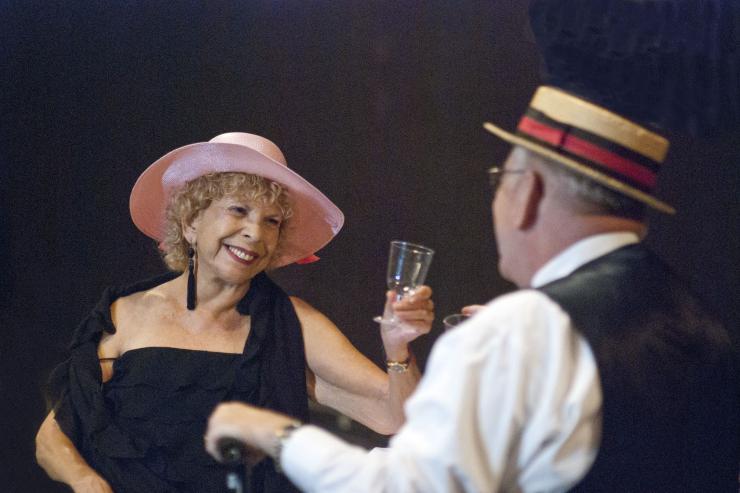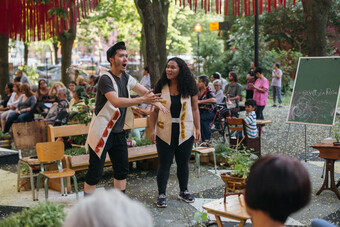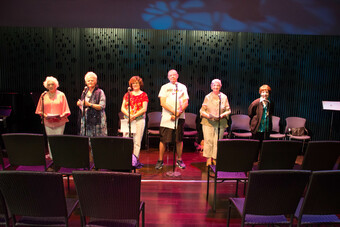Aging and Theatre
A Call to Action
Where do older adults fit into our world today? This question is currently one of great concern, politically, socially, and artistically. The growing field of Senior Theatre is one bold response. Through this week's series, we'll explore the many facets of this small but growing field. These stories highlight the sometimes-hidden power of the eldest members of our community, and share how much they have to offer to the world through their art.
According to the US Census, by the year 2030, 21 percent of the United States population will be over sixty-five.
This statistic is likely something you’ve heard before, if abstractly. We are told again and again the potential negative effects we’ll experience when nearly a quarter of our society is older adults. Who can forget the intense debates regarding how this population will overburden Social Security? There is rampant worry that our health care system will become overwhelmed by a growing number of people who suffer from the ailments of aging. And changing family dynamics are leaving more and more older adults—those who can no longer attend to their needs independently—with no choice but to leave their homes and go into a senior residential facility. Although there are many well-run, comfortable facilities, one cannot disregard the growing reports of abuse and neglect as more and more people turn to nursing homes for shelter. We are reminded by politicians from all sides that our infrastructure is not enough to secure the future of America from the threat of aging.
The arts have hardly made an appearance in this discussion. But theatre should. It must.
Together, through theatre, we can rewrite the story of aging. It’s all about enabling older adults to remind their communities that with age comes strength, beauty, and power.
Right now, our society is pushing older adults into the fringes. Just think to yourself, How many adults over sixty-five years do I see each day on the street? Over seventy-five? Over eighty-five? Likely, as the age goes up, the number decreases exponentially. This is at least partially because our society does not see value in aging. As we age, there is less and less support to engage with the world. It is ironic, then, that this group also has so much to impart—a lifetime—that is too often left unshared.
I’m not going to deny that there are economic and infrastructural issues that must be addressed, but there’s more at play in these conversations than what meets the eye. Take a moment to consider: When’s the last time you’ve seen an older adult who isn’t a wealthy senator/CEO/pundit share their perspective on the issues in a public forum? Or, how often do you see an older adult portrayed in film, theatre, or on TV as not only a dynamic character, but as one who doesn’t die in the end? How often are those stories written by or with older adults, as opposed to younger adults reflecting on their relationships and guessing about what is to come?
When we do see representations of older adults, they are too often distilled into stereotypes: wise, angry, nagging, often helpless, and dying. These ageist tendencies are strikingly similar to the continued issue of whitewashing in media. Just as in issues of race, there is a distinct lack of diversity in characters for older adults, which may in part be because there is an underrepresentation of writers over the age of fifty, much less sixty-five. The resulting stereotypes do not reflect the rich and diverse personalities of older adults today, and rarely reflect their perspective accurately.
So, what are we to do? How are we, the theatre practitioners, supposed to turn these very large-scale issues around?
We have the tools. I’m sure I preach to the HowlRound choir when I say that ours is an art centered on connectivity, collaboration, and empowerment. Together, through theatre, we can rewrite the story of aging. It’s all about enabling older adults to remind their communities that with age comes strength, beauty, and power. By engaging older adults in theatre—as actors/singers/dancers, directors, playwrights, storytellers, students, teachers, audiences—we can change the conversation from, “How are we going to deal with the elderly?” to, “I never imagined they could do that!” to, “What do you want to do next?”
On a more individual scale, there is scientific evidence that theatre activities can improve the health and vitality of older adults. This was most recently shown through research conducted by Helga and Tony Noice, faculty of Elmhurst College. Their study indicated that when older adults are exposed to acting instruction, memory and cognitive functions improve significantly. Subjects also experienced a greater sense of well-being.
I will admit that I began working on this series in an attempt to better inform my developing interest in the field of Senior Theatre. As part of a class in applied theatre last spring, I was paired up with a senior residential facility in Boston. I started out leading a weekly literary exploration group, but have since started volunteering as the leader of the new Drama Group. As a young teaching artist who entered the field with little experience with this age group (and even less experience starting a new program), I saw the curation of a HowlRound series as an opportunity to glean the wisdom of those who are already in the field of Senior Theatre. And I must say, I’ve been warmed by the outpouring of interest and passion from the Senior Theatre community.

The work that is currently being done in Senior Theatre is expansive, but it is still a growing field. According to Bonnie Vorenberg in her booklet Senior Theatre at a Glance,
In 1999, there were 79 Senior Theatre companies. By 2001, 291 companies had emerged; in 2002 there were 378, and in 2003 there were 419 groups. You can imagine our excitement when, in 2005, the number of Senior Theatre companies in the United States topped 500. As of 2015 there are over 800 companies.
Throughout the Senior Theatre series on HowlRound, you will meet a handful of the directors, playwrights, publishers, and community organizers who are helping define this burgeoning field. They will share their work, their successes and challenges, and their passion for working with amazing people with amazing things to contribute to the world.
Before signing off, I would like to share a brief anecdote from my work with older adults here in Boston:
This past month, my Drama Group has been planning and filming a short comedy about the nursing station at their residential facility. During filming, we improvised several lines to describe a character who was using all manner of tactics to skip to the front of the line and see the nurse. After having some trouble coming up with a phrase, one of the residents suggested, “Johnny Come Lately”. When I asked the others what it meant, they were shocked I didn’t know it, but kindly explained it to me. Then one of the residents began to smile, and said, “You’re going to learn so much from us.” The others also began to smile and nod.
And they’re right. I’m going to learn so much from them.








Comments
The article is just the start of the conversation—we want to know what you think about this subject, too! HowlRound is a space for knowledge-sharing, and we welcome spirited, thoughtful, and on-topic dialogue. Find our full comments policy here
As I've aged I seem to have become a "3D" actor: the characters I'm cast as are decrepit, demented, and/or dying. In life? I can't remember where I left my keys-- but I never could! My reflexes, vocabulary, ability to follow a complicated plot or argument or prepare a feast for 15 don't seem to be declining, and my tennis game is better than it was at 45. But unless I consciously turn on my "inner spotlight" people in that key demographic of 18-49 do look right through me. I'm no longer a source of advice or the recipient of confidences or a
Lynn Mullin is spot-on in identifying a problem -- that
"older adults" are being "pushed into the fringes." It's
that problem, I note, that all the comments in this piece so far are
addressing.
I think it's terrific that there are now 800 companies in
the United States that reportedly identify themselves as "Senior
Theatre." But the Senior Theatre movement doesn't really address the
issues surrounding ageism (in theater and in society at large), and indeed, I’m
sorry to say, its existence may inadvertently contribute to some
misconceptions.
We live in a country in which the average male lives
to the age of 76, and the average female to 81. Many people of course live much
longer. Yet, ask any television executive who they are aiming to attract as
viewers, and the answer is those aged 18 to 49. That age range is called
the "key demographic" or simply "the demo." The attitude
towards older performers in Hollywood (Meryl Streep excepted) is well
documented. TV and movies are explicit about this bias, but it’s hard to
escape the existence of a similar attitude in the theater; one need only keep
up with theater publications and websites to see rants against “old” audiences
and audience members on just about a weekly basis.
What we’ve done as a society is to label people who can be
as young as 50 as “older adults,”
and then lumped them all together.
The working playwright who commented below is put in the same category
as the now-disabled person struggling with medical issues in a “senior
residential facility.” For half
their adult lives, people are now being dismissed as irrelevant, and patronized
or even resented.
My hope is that “Senior Theatre,” which (in a later essay in
this series) Senior Theatre Resource Center founder Bonnie Vorenberg likens to “Children’s
Theatre” and “Community Theatre,” won’t take the pressure off “Theatre” to be
inclusive of all ages at all times and in all ways.
I'll be following this series, excited that one installment might address work being done to change how we manage and educate artists (actors/writers/directors) of al ages so that they may learn that thriving physically, aging, and working are not just possible, but can also become the norm. I frequently wonder, when reading an article about an actor who comments on almost being too old (in 70s) to physically play a role like Lear, how we change the story our theatre artists are telling not just audiences, but also themselves about what it is like to age.
If you think about it this way, older adults have been overly "medicalized" by the healthcare industry. The shift we are seeing now is a refocusing on life-long learning for older adults - who don't want just "treatment" but opportunities for engagement, learning, creation, purpose - in short, LIFE. The arts provides an invaluable opportunity for this as it is an emotional and symbolic language that can draw people together across differences of culture, age, ability - to create something new together. It is indeed a growing field with arts students discovering it as well as a meaningful opportunity for career. It is crucial, however, that we don't give senior theatre groups a pass of the images they create. That would be condescending. Sometimes the images are rehashing of stereotypes - sometimes they are bold revisioning of the world. There is a wide range and we should address it as a real segment of theatre with the capacity for rigorous, serious artmaking - not just a quaint subset.
This is a wonderful phrase, "A quaint subset" I am a playwright who is 65 and what I often read about are senior theatre groups that seem to me to be 'day care,' - nothing too deep, a sort of self-deprecating humor about old age, like those awful greeting cards you see. Being that I am at the fringes of this older group I don't see myself that way and don't understand why, as older people, we buy into making this ageism even more public than it is. Any older characters I write are not there as physical comic relief; they are fully fleshed out human beings.